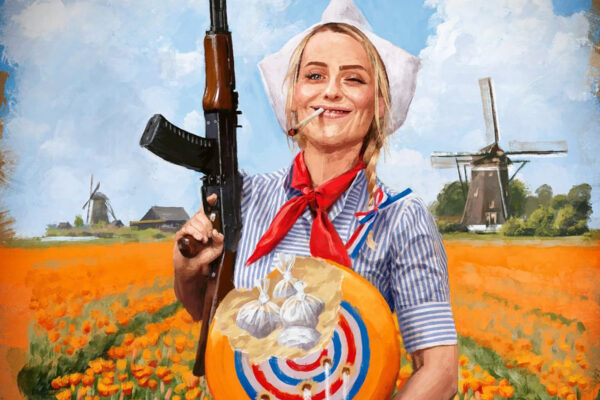
Der Spiegel makes a mockery of the Dutch drug policy. Under the header “Käse, Koks und Killer” (Cheese, Coke and Killers; English version here), the German weekly portrays the Netherlands’ stereotypical Frau Antje with a joint between her lips, a Kalashnikov in one hand and a round cheese stuffed with cocaine in the other. The Netherlands, it claims, is “terrorized” by drug traffickers.
To Germans who are thinking of following the Dutch in decriminalizing cannabis, Der Spiegel has a clear warning: don’t, or we’ll suffer the consequences.
Crime
The report is packed with examples of brutal crimes and estimates of mega-profits made by drug lords.
It doesn’t place those figures in an historical context. Nor does Der Spiegel tell its readers how many drugs are consumed in the Netherlands, how that compares to Germany, and what its effect is on Dutch public health. Those figures tell a different story.
The Dutch have been alarmed by a number of high-profile drug-related murders: of lawyer Derk Wiersum, whose client was due to testify against a suspected drug lord, in 2019 and crime reporter Peter R. de Vries, who advised the same witness, in July.
With twenty to 25 assassinations per year, the number is higher than in the last century but below the peak of 2014, when there were 34 assassinations.
Der Spiegel blames the “naive” Dutch approach to drugs, but that accusation isn’t borne out by facts.
Dutch police and prosecutors spend between 20 and 30 percent of their budgets on drug cases every year. Investigations into drug cartels have doubled in five years. With effect: drug offenses have gone down from 18,000 to 13,000 in a decade, or 1.6 percent of all crimes. One in five prisoners was convicted of a drug-related offense.
If anything, the numbers suggest the Dutch criminal justice system devotes too much resources to drugs, not too little. Drug crimes are a tiny share of the total. Drug use in the Netherlands is low by European standards.
Drug use
11 percent of the Dutch under 25 have tried cannabis. In Germany it’s 17 percent. German cannabis use has increased in the last twenty years. In the Netherlands it’s been stable.
German teenagers know how to get their hands on drugs better than their Dutch peers. 15 percent claim they know how and where to find cocaine. 20 percent claim they could get MDMA. In the Netherlands, the figures are 11 and 16 percent, respectively.
German aren’t bluffing. Once they grow up, they use more drugs too. 1.6 percent of Germans under the age of 35 consumed cocaine last year compared to 1 percent of the Dutch.
Much of that cocaine is shipped from South America through Rotterdam, “Germany’s largest port.” We don’t know how much exactly. Customs probably intercept only a fraction. But authorities estimate Germany is the fifth-largest buyer of cocaine in Europe.
The Dutch didn’t choose to be on the North Sea, but hundreds of thousands of Germans make the decision every year to snort cocaine. Who’s causing the problem here?
Germans are also heavier users of amphetamines, GHB and heroin. The Dutch prefer MDMA, or ecstasy. More than half of under-35s in the Netherlands have tried ecstasy, but few become long-term users. Just 3 percent did ecstasy last year, compared to 1.2 percent of Germans. The Netherlands is the top ecstasy producer in Europe, but guess who are the second-largest dealers?
Deaths and addiction
Just over 200 people die from drug use in the Netherlands every year. For comparison: alcohol kills 1,900 annually while more than 20,000 die from smoking tobacco. Cannabis doesn’t kill anyone.
It puts the Netherlands near the bottom of drug deaths in Europe. Only France has fewer fatalities relative to its population. Germany has twice as many: 23 for every one million inhabitants.
HIV infections caused by sharing needles have steadily fallen in the Netherlands. In Germany the number has been rising again since 2011.
Addiction centers in the Netherlands see fewer and fewer applicants every year. That number, too, is going up in Germany.
Der Spiegel ought to take a look in the mirror: their own people have a bigger drug problem than the Dutch.
